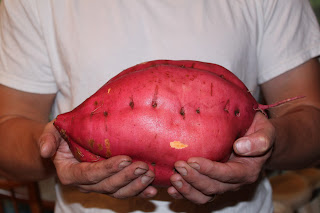The garden isn’t completely toast, but it’s close. Out of the roughly 25 total rows of veggies in the garden (some of which got replanted mid-season after the first crops petered out), only 3 remain. We lost our last row of green beans when we failed to cover it before last week’s unexpected (at least by us) frost, along with our half row of eggplant. The half-row of swiss chard is hanging tough & standing tall, along with the fall plantings of lettuce, spinach, and radishes that should be ready to start harvesting in a couple weeks if the weather holds out. Our Brussels sprouts are still going strong, too. Or as strong as we could hope – this is the 3rd year we’ve planted Brussels sprouts, and the first year we’ve actually gotten edible sprouts on the plants before the snow flies! The funny thing about Brussels sprouts (aside from the fact that our family actually likes to eat them, unlike 95+% of the US population!) is that it takes a solid frost to really make them really good – once they survive a good frost, they get a little less bitter. Unlike Michelle, who gets more bitter after the first frost (Really? Winter’s coming already?).
 Everything else has been harvested and put away for winter. What can be canned is canned, what can be frozen is frozen, and what can’t be kept at all has been eaten at every other meal until we’re completely sick of it (that would be you, eggplant) or put at the end of the driveway with a big “FREE!” sign (yep, a sure-fired way to get rid of anything in our neighborhood). We hung a cylinder made out of chicken wire in the garage to contain all the onions, and tied our garlic bulbs together into a big keep-away-the-vampires bridal bouquet that hangs off the top, along with a few sprigs of rosemary. The potatoes are all in a big burlap bag in the cellar where they’ll stay nice & cool. The baby reds don’t keep as well, so we’ll eat them first, saving the white potatoes until their eyes start sprouting white tentacles. At which point we’ll give them to the girls to play “octopus adventure” or practice braiding & macramé. The sweet potatoes, including the football-sized one you see pictured below, keep best in a big bucket of dry sand. This year we’re using a wide, shallow one, because last year we never finished the sweet potatoes – we got to frustrated trying to dig down to the bottom of a 5 gallon bucket full of sand. Which brings us to the butternut squash – they just sit in neat little rows on the shelves in the cellar like bowling pins. Oh, there was that sorry attempt to can spiced apple rings last weekend, which ended with a big pot of spiced apple mush and curlicues of spiced apple peel, but we’re trying to put that behind us. Let’s just say that our compost bin has a faint but lovely smell of cinnamon, cloves and overcooked apples.
Everything else has been harvested and put away for winter. What can be canned is canned, what can be frozen is frozen, and what can’t be kept at all has been eaten at every other meal until we’re completely sick of it (that would be you, eggplant) or put at the end of the driveway with a big “FREE!” sign (yep, a sure-fired way to get rid of anything in our neighborhood). We hung a cylinder made out of chicken wire in the garage to contain all the onions, and tied our garlic bulbs together into a big keep-away-the-vampires bridal bouquet that hangs off the top, along with a few sprigs of rosemary. The potatoes are all in a big burlap bag in the cellar where they’ll stay nice & cool. The baby reds don’t keep as well, so we’ll eat them first, saving the white potatoes until their eyes start sprouting white tentacles. At which point we’ll give them to the girls to play “octopus adventure” or practice braiding & macramé. The sweet potatoes, including the football-sized one you see pictured below, keep best in a big bucket of dry sand. This year we’re using a wide, shallow one, because last year we never finished the sweet potatoes – we got to frustrated trying to dig down to the bottom of a 5 gallon bucket full of sand. Which brings us to the butternut squash – they just sit in neat little rows on the shelves in the cellar like bowling pins. Oh, there was that sorry attempt to can spiced apple rings last weekend, which ended with a big pot of spiced apple mush and curlicues of spiced apple peel, but we’re trying to put that behind us. Let’s just say that our compost bin has a faint but lovely smell of cinnamon, cloves and overcooked apples. 
